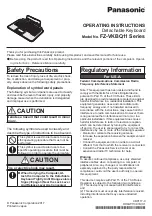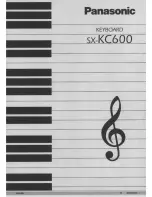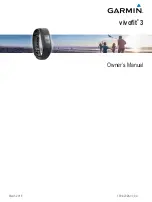
Appendices
984
Dynamic MIDI Sources & Destinations
Dynamic MIDI Sources
The sources (Dynamic MIDI Sources) are organized
into the following groups
JS +Y #01…JS X: Controller group
Short Note…Black Note: Note group
Velocity…Vel Out Z: Velocity Group
Depending on the combination of source and
destination (Dynamic MIDI Destinations), the selected
destination may not function as you intend. Refer to
the explanations of combining sources and
destinations in each section of “Dynamic MIDI
Destinations,” and make sure to select sources and
destinations that are appropriate for each other.
Off: No source will be selected.
Controller Group:
For the Controller Group, the Range Bottom and Top
fields will be available. The Range fields can be used to
chose only a portion of the normal 0–127 range if
desired. This depends on whether the actual Source is
a continuous controller or a switch. For example, if you
choose JS+Y (CC#01) and set the range to be 110–127,
then only when the joystick reaches the farthest
position away from yourself would the selected
Destination be affected. In most cases, you should
leave them set to 0–127 for normal operation, unless
you are trying to achieve a special calculated effect in
only a portion of the controller’s range.
The following Controller Group Sources correspond to
the KARMA ON/OFF switch, KARMA LATCH
switch, KARMA SCENE 1–8, KARMA SLIDERS 1–8,
KARMA SWITCH 1–8, Pads 1–8, and the CCs they are
set to respond to in the Global 2–1: Controller/Scale.
Shown are the default CC settings. If the Global 1–1b:
MIDI Filter “Enable Control Change” is checked and a
MIDI CC Message is received on the assigned
controller, it will control the Dynamic MIDI
Assignment as well as the associated control.
Two settings are “special,” in that they refer to groups
of controls: KARMA Scene-Any, and Pads-Any. When
these are selected, the operation of any KARMA
SCENE switch or any Pads 1–8 respectively can be
intercepted and used as a Dynamic MIDI Source.
While all of the Real-Time Controls are able to be
assigned in their normal operation to do various
things, there are times where using them through
Dynamic MIDI can be useful. For example, the
KARMA SCENE switches can be used to retrigger the
groove at a scene change, stop any melodic repeats so
that they don’t overlap the scene change, or change a
parameter value in the Real-Time Parameters of a GE,
etc. Pads can be set to repeatedly trigger modules each
time they are pressed, yet the module can be in “1st”
Trigger Mode, so that playing the keyboard doesn’t
retrigger the start of the groove. And the Latch switch
could be used to change the Key Zone range or the
Latch Mode for a module’s envelopes.
Furthermore, by running a KARMA SLIDER through
Dynamic MIDI and into Real-Time Parameter Control,
rather than assigning it to an Real-Time Parameter
directly, you can choose only a portion of the slider’s
range to affect the parameter. For example, if you
selected KARMA SLIDER 1 as a Dynamic MIDI
Source, and set the Bottom/Top to 110/127, then only
at the end of the slider will the slider’s values affect
any destination parameters assigned through Real-
Time Parameters Control.
JS+Y (CC#01)
The +Y direction (away from yourself) of the joystick
(CC#01) will be the source.
JS-Y (CC#02)
The –Y direction (toward yourself) of the joystick
(CC#02) will be the source.
Pedal (CC#04)
The assignable foot pedal (CC#04) will be the source.
The function of the assignable pedal connected to the
ASSIGNABLE PEDAL jack must be assigned as Foot
Pedal (CC#04) for the Global 2–1: Controller/Scale
page “Foot Pedal Assign” parameter.
Damper (CC#64)
The damper pedal will be the source.
Porta. SW (CC#65)
The portamento switch (CC#65) will be the source.
Foot Switch (CC#82)
The assignable foot switch (CC#82) will be the source.
The function of the assignable foot switch connected to
the ASSIGNABLE SWITCH jack must be assigned as
Foot Switch (CC#82) for the Global 2–1:
Controller/Scale page “Foot SW Assign” parameter.
MIDI (CC#83)
MIDI control change CC#83 will be the source.
Ribbon (CC#16)
The ribbon controller (CC#16) will be the source.
VJS X (CC#118)
The X (horizontal) direction of the vector joystick
(CC#118) will be the source.
Note:
If you want to use the ±X axis of the vector
joystick as a source, set the Global P2–1c: MIDI CC#
Assign-Vector Joystick/Pads parameter “VJS X” to
CC#118.
VJS Y (CC#119)
The Y direction (vertical) of the vector joystick
(CC#119) will be the source.
Summary of Contents for Electronic Keyboard
Page 1: ...Parameter Guide Parameter Guide ...
Page 2: ......
Page 180: ...Program mode EXi 170 ...
Page 290: ...EXi STR 1 Plucked String 280 ...
Page 572: ...Sequencer mode 562 ...
Page 700: ...Global mode 690 ...
Page 751: ...Insert Effects IFX1 IFX12 Routing 741 Fig 2 3a Fig 2 3b ...
Page 902: ...Effect Guide 892 ...
















































